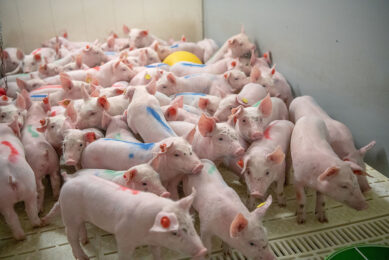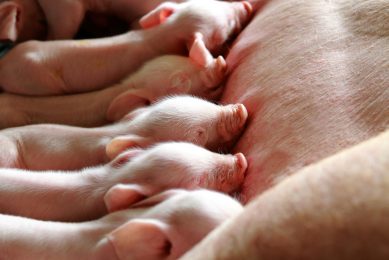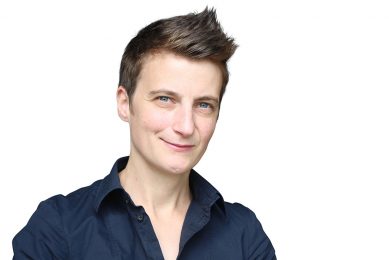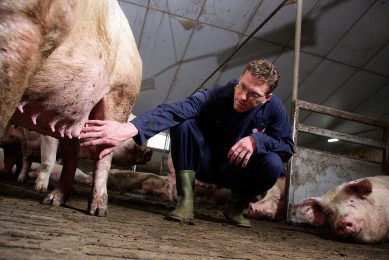Home is where the hygiene is
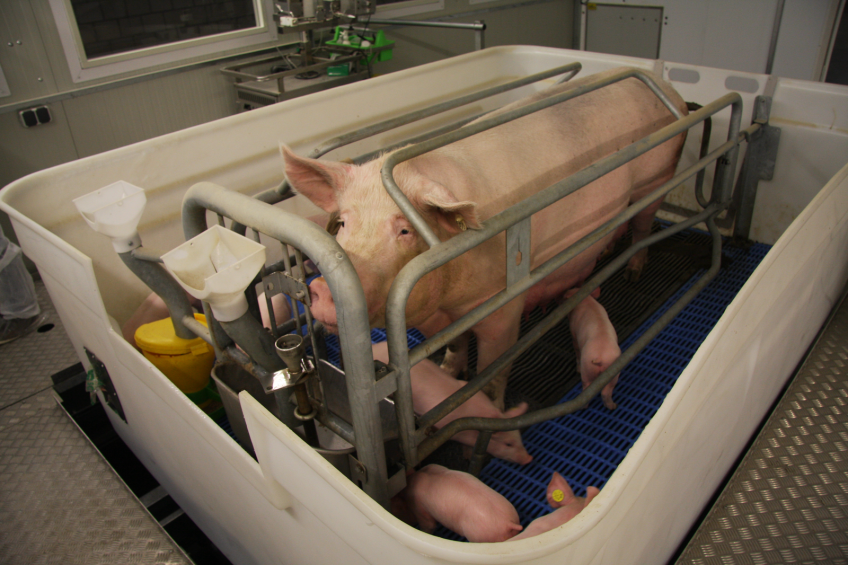
Nutrition, genetics, equipment… Many improvements have been made to maximise efficiency in pig production, but what about redefining a whole new approach to pig farming with hygiene as the primary focus. MS Schippers have done just that.
De Zwartakkers Farm in Bladel, the Netherlands is not your average pig farm. Behind the recognisable exterior lies a brand new concept in pig farming. The farm, property of Dutch ‘hygiene and health concepts’ company, MS Schippers is the test facility of their new housing concept Hy-Care. The system is still in the prototype stage, but it is already generating interest in the industry. This was helped by receiving the gold medal award at the 2014 EuroTier tradeshow in Germany.
[([002_69_rb-image-1753250.jpeg]:inzetmiddel)]
De Zwartakkers Farm, the Netherlands
Farm type: Trial farm
Farm size: Six sows per trial round
Number of rounds: 13, since research began in July 2014
Hy-Care is a housing system whereby piglets are born and weaned in the same environment until day 62 and kept in strict hygiene conditions. The idea is fairly simple in its concept but as R&D manager, Victor van Wagenberg points out, “it’s a complete system change.”
Where did the idea come from? “Animal husbandry is often linked to antibiotic resistance in human medicine, therefore it is also the industry’s responsibility to prevent pigs from getting ill in the house,” Van Wagenberg argues. “Illness in pigs is often caused by ourselves because of cross-contamination; illnesses are spread throughout the pig house. In human healthcare everyone knows that hygiene is paramount, now we want to implement this thought in the pig house. It is a recognised problem that illness spreads quickly through a pig farm and we want to contain that. The main philosophy behind the Hy-Care system is to keep brothers and sisters together and avoid cross-contamination and to start every round with a 100% germ free pen.”
[([003_264_rb-image-1753249.jpeg])]
Victor van Wagenberg, R&D manager, MS Schippers: “We’re not solving problems, but preventing them.”
System set-up
To avoid cross-contamination, it’s not the animals are being moved around, but their pens, large bathtub-like plastic moulds of over 1 m high to avoid piglets jumping out. With the pens having to be mobile, the set-up of a pig farm had to be fundamentally re-thought.
Currently, the Hy-Care system is divided into five segments, each segment being a zone where an entire pen can be moved to. The five segments are:
Farrowing
The sows are housed here from five days prior to farrowing until five days after farrowing, with birth on day 0. This area is labour intensive and walkways are present between the pens to allow the farmer to carry out necessary tasks such as birth assistance, tagging and tail docking. In this room the pens are accessible on three sides.
[([004_459_rb-image-1753257.jpeg]:inzetgroot)]
Peace and quiet inside a pen located in the farrowing area.
Nursery/Weaning rooms
Five days after birth the pens, including piglets and sow, are moved here. The piglets in this stage don’t require continuous attention, so regular management practices can occur. All pens are checked twice a day and if extra care is needed the pen is then transported to the working place. At weaning (28 days), the sow is simply removed, piglets in their entirety walk into a new, cleaned pen of exactly the same size, just without a farrowing crate, and they go back again.
[([005_755_rb-image-1753246.jpeg]:inzetgroot)]
View from inside the piglet pen. Especially after weaning, piglets have been observed to grow rapidly in the Hy-Care system.
Working place
This is where further treatments are conducted in the nursery/weaning phase if necessary, pen per pen.
Toilet
The pens are individually brought out to the toilet facility which is vacuum pumped out of the pen. This occurs once a week when the sow is present in the pen.
Washing machine
This area is currently under construction; this is where after 62 days the pens are efficiently washed and made germ free ready for the next round.
[([006_198_rb-image-1753247.jpeg]:inzetgroot)]
The toilet area – by moving the mobile pen on top of this platform, a pipe is connected to the pen which allows it to release all manure.
The experimental farm houses three departments with room for 12 pens per department. The individual pens, made of durable plastic are 5 m2 (2.6 m x 1.9 m). They have been moulded specifically to these dimensions and are manufactured in the Netherlands. The pens are transported around the farm using two internal transport systems, given the names Asterix and Obelix. This technology already exists in other industries. On a fully automated system, Obelix glides down the large, wide corridors and can enter the farrowing and weaning rooms to collect individual pens and bring them to another location. Within the so-called working place where additional treatments are administered the pens are transferred to the smaller Asterix system.
Economising space
On entering the farrowing room at De Zwartakkers Farm, six pens can be seen stacked in two layers of three. Stacking the pens is a solution for economising space as wide transport alleys are needed on the facility for transporting the pens and it can be argued that this increases land-use efficiency.
Through the plastic which is lit via the warming lamps above shadows are cast of piglets getting used to their new home. At what first glance, may seem to be other-worldly filled with friendly robotic machinery and piglets stacked in pens, this could offer a glimpse of the future.
[([007_665_rb-image-1753248.jpeg]:inzetgroot)]
Transport system Obelix is transporting a pen with sow and piglets away from the farrowing area.
“We don’t perform magic,” Van Wagenberg points out. “We’re not solving problems, but preventing them. In fact we are offering very simple and realistic solutions.”
Everything has been considered within the system to prevent cross-contamination. Minimum contact is required with the piglets and it is compulsory that the farmer washes their hands between pens. Manure, which is a literal cesspit for bacteria to breed, is now managed pen per pen. Each pen has its own shovel for removal of waste generated by the piglets, after the sow has left and the pen no longer has a large enough volume to warrant being taken to the toilet area.
By containing the pigs in their own pen from birth until 60 days old, the pigs are not exposed to bacteria from other groups. As opposed to conventional farming where pigs walk along alleys within the pig farm to get to new housing for weaning their exposure to harmful bacteria here is limited.
Trial data
Since the start of the trial on 1st July 2014 the experimental farm has completed 13 rounds of production, gathering data from 1,800 piglets. Each round, which was roughly every two to three weeks, six sows were brought into the complex five days before birth. Due to local veterinary legislation about replacing sows, only old sows where used on the research farm and where sent to slaughter afterwards.
[([008_303_rb-image-1753253.jpeg]:inzetgroot)]
Obelix moving the pen through the aisle. The system has been in use in different industries but can also be applied in pig production.
For research purposes six sows from the same group were sent to a nearby reference farm to farrow/wean conventionally and these two groups of six were compared. There was an average of 12 piglets per sow in both systems and mortality was also the same. The piglets in the Hy-Care system reached 7.6 kg at day 26, which was the designated time for weaning and transfer to another pen. From day 26-61 the piglets were measured again. On average, at day 61 the piglets in the Hy-Care system were 5 kg bigger than those in the reference farm which incidentally was also producing above the Dutch average.
Daily growth was monitored at 0.515 kg in the Hy-Care system compared to 0.378 kg, an improvement of 36%. Van Wagenberg says, “We changed a lot of things, so it’s hard to really specify why the results are so much better. In terms of feed, we used one of the cheapest feeds available on the market, so even with a basic diet the growth rate saw substantial growth. Of course, the major factor is hygiene. The piglets have lived a completely germ-free environment with a good climate system creating the optimal conditions.”
Antibiotics
Antibiotic use was also monitored and throughout the year, limited problems with health were recorded. Only two groups received treatment and this was for diarrhoea. In the Hy-Care system the antibiotic defined daily dose (DDD) was 0.55, and in the reference farm this was 5.0, with the 2013 average in the Netherlands being 10.9. “If you keep the animals healthy, then you hardly need antibiotics,” explains Van Wagenberg.
The project has had a lot of input and support from many technical and research institutions, such as the Swine Innovation Centre in nearby Sterksel, part of Wageningen University. As Van Wagenberg points out, many disciplines are needed to develop something like this. Research conducted by Utrecht University showed that the rectal temperature of piglets post-birth was +0.6%. This extra warmth is due to the lack of draft offered by the plastic pen. “The pen is like a plastic drawer,” Van Wagenberg explains. “No air can flow in or out, which offers the piglets a warm, draft-free environment.”
[([009_857_rb-image-1753254.jpeg]:inzetgroot)]
Sow and litter arrive in the working place area, for further treatments. The pen is brought into the working place on the Asterix system.
The future
Although the pens are not yet for sale the company envisages that the complete system will cost around € 4,000 per pen, which they argue is not more than a conventional facility in total and in reach of a normal investment. The next step in the development of the product is to build a full-scale Hy-Care house.
When MS Schippers announced their plans for the Hy-Care housing system, eyebrows were raised in certain quarters even to the point of questions being raised in Dutch parliament who wanted to know what exactly was happening on the experimental farm. In response the company has been gathering knowledge and facts and collecting data on what people think. Van Wagenberg says, “We have nothing to hide but we recognise that people require further explanation in what we’re doing and we’re happy to engage in social discussion about this. We see in this Hy-Care system something different than other people may see.”
“It’s too high to climb in,” one farmer noted on inspection, to which Van Wagenberg laughed and replied, “exactly, it’s too high to climb in. There’s always two ways of interpreting the same thing.” Everything has been determined with optimising the hygiene environment of the piglets. But is this the future of pig farming? “I expect this to be a part of the reality,” concludes Van Wagenberg smiling.



